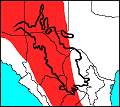


Myotis thysanodes. Photograph credit: BLM/Utah.
The Fringed Myotis prefers to live in desert scrublands, grasslands, and woodlands comprised of oak, pine, and juniper (Tuttle 2003). These are colonial bats (the colonies may number several hundred individuals) that roost in caves, mine tunnels, rock crevices, and old buildings (Schmidly 1977). This is a migratory bat that arrives in Trans-Pecos by May, when it begins to form its nursery colonies. "Two and possibly three nursery colonies have been located in Big Bend National Park, with the largest at Mariscal Bat Cave." (Schmidly 1997:39). The colonies begin to disperse in October, and according to Davis and Schmidly (1994), the winter locales and habits of this bat remain a mystery.
Davis, W. B., and D. J. Schmidly. 1994. The Mammals of Texas. Texas Parks and Wildlife Press, Austin
Schmidly, D. J. 1977. The mammals of Trans-Pecos Texas including Big Bend National Park and Guadalupe Mountains National Park. Texas A&M University Press, College Station.
Tuttle, M. D. 2003. Texas bats. Bat Conservation International, Inc., Austin.
A. Ruth Huckaby, Graduate Student, BIOL 5301—Natural History of the Chihuahuan Desert, June 2006.
Huckaby Update: 22 Jun 2006
Last Update: 23 Jul 2009